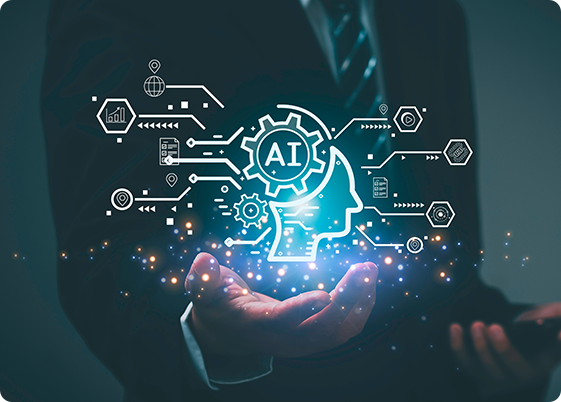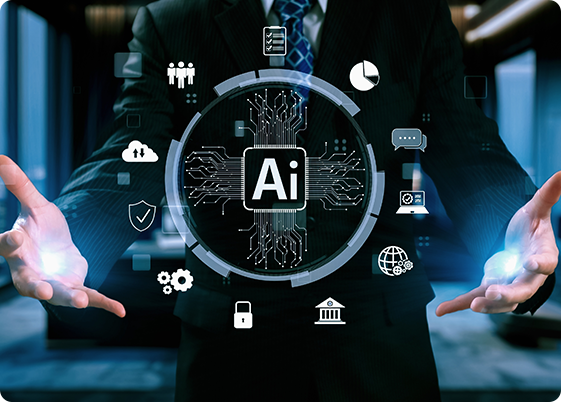What is Generative AI? Everything You Need to Know
Generative AI, or Generative Artificial Intelligence, is a subfield of AI focused on creating new content using algorithms. This can include anything from text and images to music and even software code. Unlike traditional AI models that classify or predict based on existing data, generative AI models can create new data that mimics the patterns and characteristics of the original dataset. But what is generative AI mean in practical terms, and how does it work? In this complete guide, we'll explore its types, applications, benefits, and potential challenges

What Is Generative AI?
Generative AI refers to AI systems designed to generate new content by learning from existing data. These models use deep learning techniques to understand patterns in the input data and then create outputs that resemble the original data. For example, a generative AI model trained on thousands of landscape paintings could create a completely new and original painting that follows the style and technique of the artworks it has studied.
Generative AI works by leveraging complex neural networks, such as Generative Adversarial Networks (GANs) or Transformer Models, to produce outputs that are indistinguishable from human-created content. The goal is to create a model that can not only imitate but also innovate, providing new ways for businesses and industries to utilize AI technology.
Types of Generative AI Models
Generative AI encompasses several types of models, each with unique characteristics and use cases. Here are the four primary types:

Generative Adversarial Networks (GANs)
Generative Adversarial Networks (GANs) are among the most popular and widely used generative AI models. GANs consist of two neural networks—the generator and the discriminator—that work against each other. The generator creates new content, while the discriminator evaluates the quality of the generated content against real data. Over time, the generator improves its ability to create more realistic outputs, and the discriminator becomes better at detecting flaws, leading to high-quality, realistic results.
Beyond media production, GANs have applications in numerous fields, including art and design, where they can generate new artwork or music, and medicine, where they can create realistic medical images to assist in training or diagnostics. They are also used in finance to generate synthetic data for algorithmic trading models or risk management.

Variational Autoencoders (VAEs)
Variational Autoencoders (VAEs) are another type of generative AI model that use probabilistic approaches to generate new data. VAEs work by compressing the input data into a latent space, which represents the core characteristics of the data, and then reconstructing the data from this compressed form. By learning the distribution of the data, VAEs can generate new, similar content.
VAEs are particularly useful in applications where generating new data with specific characteristics is important. For example, in drug discovery, VAEs can generate new molecular structures that adhere to certain chemical properties, potentially identifying new compounds with desired therapeutic effects. In the field of creative industries, VAEs can be used to generate new designs or artworks that retain certain stylistic elements while introducing new variations. They are also used in anomaly detection, where the model learns to recognize what constitutes "normal" data and identifies outliers that deviate from this learned distribution.

Recurrent Neural Networks (RNNs)
Recurrent Neural Networks (RNNs) are designed to handle sequential data, such as text, speech, or time-series data. RNNs use loops to retain information from previous steps, making them well-suited for tasks that involve patterns over time. In generative AI, RNNs can generate text, music, or any other sequential data by predicting the next element in a sequence based on previous elements.
In generative AI, RNNs are often used in applications such as chatbots, where they generate natural-sounding responses, and in language translation, where they learn to translate text from one language to another based on the context of surrounding words. They are also used for predictive text generation, helping to autocomplete sentences or predict the next word based on previous input.

Transformer Models
Transformer Models represent the latest advancement in generative AI, particularly in natural language processing (NLP). Unlike RNNs, transformers do not rely on sequential data processing, which makes them faster and more efficient for handling large datasets. Transformers use a mechanism called "attention" to weigh the importance of different parts of the input data, allowing for more complex and context-aware outputs.
The most notable example of a transformer model is GPT-3 (Generative Pre-trained Transformer 3), which has set new benchmarks in NLP tasks such as automatic text generation, summarization, language translation, and conversational AI. Transformer models like GPT-3 can generate human-like text, answer questions, create poetry, and even write code, showcasing their versatility and power. Beyond NLP, transformer models have also been applied in image and video generation. For instance, models like DALL-E use the principles of transformers to generate images from textual descriptions, demonstrating the adaptability of this technology across multiple domains.
In summary, GANs, VAEs, RNNs, and transformer models each offer unique capabilities that make them suitable for different generative AI tasks, from creating realistic images to generating text and predicting sequences. By leveraging these models, businesses and researchers can push the boundaries of what is possible in AI, driving innovation across a wide range of fields.
Applications of Generative AI
Generative AI is revolutionizing various industries by enabling new possibilities and enhancing existing processes. But, what are the applications of generative AI? Some of them are given below:

Healthcare Industry
In healthcare, generative AI is playing a crucial role in enhancing patient care, accelerating drug discovery, and improving diagnostic accuracy. Generative Adversarial Networks (GANs) are being used to create synthetic medical images that train AI models while protecting patient privacy. For example, they can generate realistic MRI or CT scans to help develop more accurate diagnostic tools. Additionally, Variational Autoencoders (VAEs) are being leveraged to generate new molecular structures that could be potential drug candidates. This accelerates the research and development process by significantly reducing the time required to identify promising molecules for new treatments. Generative AI also assists in developing personalized medicine by simulating how individual patients might respond to different treatments, thereby tailoring healthcare to each person’s unique needs.

Education Industry
Generative AI is revolutionizing the education sector by personalizing learning experiences and making education more accessible. AI models can create customized learning materials that adapt to each student's pace and style, enhancing the learning process. For example, AI-driven platforms can analyze a student's performance data and generate specific quizzes, lessons, or interactive content tailored to their strengths and weaknesses. This makes education more engaging and effective, especially for remote or self-paced learners. Additionally, AI-generated virtual teachers and tutors can provide support 24/7, offering explanations and assistance as needed. By generating a range of educational resources, such as textbooks, interactive simulations, and adaptive tests, generative AI helps educators save time and focus on individual student needs, thereby improving overall educational outcomes.

Financial Industry
In finance, generative AI is utilized to enhance risk management, fraud detection, and customer interactions. For instance, GANs can simulate various market scenarios, providing traders with insights into potential risks and opportunities, which aids in making informed trading decisions. In fraud detection, generative AI creates synthetic data sets that are used to train machine learning models, improving their ability to detect and respond to fraudulent activities. This is particularly valuable for identifying complex fraud patterns that might not be evident with traditional data alone. Additionally, AI-driven chatbots, powered by generative models, provide personalized customer service by understanding and responding to customer queries with high accuracy, improving client satisfaction and engagement.

Creative Industry
Generative AI is significantly impacting the creative sector by enabling artists, designers, musicians, and writers to explore new frontiers of creativity. AI tools can generate original content, such as music, artwork, and literature, often at a scale and speed that would be impossible for humans alone. For example, GPT-3, a language model, can write compelling stories, articles, or scripts, while GANs can create new pieces of visual art that mimic specific artistic styles. In music, AI algorithms can compose original melodies or assist in producing complex soundtracks. This technology is also being used in the film industry for scriptwriting, special effects, and even generating digital actors, allowing creators to experiment with innovative forms and ideas.
Generative AI is redefining how industries operate, innovate, and deliver value by enabling new possibilities and improving existing processes. From healthcare to finance, education to creative sector, and beyond, the applications of generative AI are vast and varied. As the technology continues to evolve, it will undoubtedly open up even more opportunities for innovation, efficiency, and growth across multiple sectors.

Benefits of Generative AI for Business
Generative AI benefits for business ranges from cost savings to enhanced innovation. Check out some mentioned below:
- Cost Reduction: Generative AI can significantly reduce operational costs by automating tasks that traditionally require substantial time and human effort. For example, AI can automate content creation, design, data generation, and report writing, minimizing the need for manual intervention and reducing reliance on external resources like creative agencies or data analysts. This automation helps businesses allocate resources more efficiently and achieve better financial outcomes.
- Enhanced Creativity: AI tools are not just efficient; they are also a source of inspiration. Generative AI can analyze vast datasets, uncover patterns, and suggest innovative ideas that humans might overlook. This capability accelerates the creative process, allowing businesses to develop new products, services, and marketing strategies more quickly. It can generate unique content, design elements, and product prototypes, giving businesses a competitive edge in the market by enabling them to innovate faster and more effectively.
- Personalization: One of the most powerful applications of generative AI is in creating personalized experiences. AI models can analyze customer data to generate personalized content, offers, and product recommendations tailored to individual preferences and behaviors. In customer service, AI-driven chatbots can provide customized responses based on customer history and inquiries, enhancing the overall customer experience. In marketing, AI can automate the creation of personalized emails and advertisements that resonate with specific audiences, improving engagement and conversion rates.
- Improved Decision-Making: Generative AI aids businesses in making faster, data-driven decisions by simulating various scenarios and analyzing potential outcomes. By providing insights based on extensive data analysis, AI models help organizations understand market trends, customer behavior, and operational challenges. This ability to predict outcomes and assess risks enhances strategic planning, allowing businesses to respond swiftly and accurately to changing conditions.
- Scalability: Generative AI models are designed to handle large volumes of data and generate outputs at scale. This is particularly beneficial for businesses looking to expand, as AI can manage increased workloads without compromising performance. Whether it’s processing massive amounts of customer data, creating content for multiple channels, or generating thousands of product descriptions, AI scales effortlessly to meet growing demands, ensuring businesses remain agile and responsive.
By integrating generative AI into their operations, businesses can achieve a powerful combination of cost efficiency, creative innovation, personalized engagement, informed decision-making, and scalability, positioning themselves for sustained growth and success in a competitive market.
Conclusion:The Future of Generative AI
The future of generative AI is incredibly promising, with advancements in neural networks, data processing capabilities, and AI-driven innovations expected to continue. While there are Generative AI challenges, such as the potential misuse of AI-generated content, ethical concerns, and the need for better transparency, the benefits far outweigh the drawbacks of Generative AI. As businesses across industries embrace this technology, the demand for experts in generative AI will increase, creating new opportunities in fields like software development, data science, and digital marketing. This surge in demand will also fuel growth in IT jobs in the USA, especially in areas like AI research, machine learning engineering, and cloud computing.
Generative AI is poised to reshape the way we think, work, and create, and understanding its potential will be crucial for businesses looking to stay ahead in an increasingly digital worl
🎧 Discover more in our podcast as we break down what generative AI is.
 US
US Canada
Canada Colombia
Colombia India
India Jamaica
Jamaica Philippines
Philippines UK
UK SA
SA
